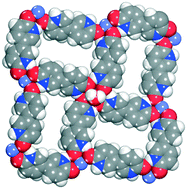Building coordination polymers using dipyridone ligands†
Abstract
By examining the crystal structures of the self-assemblies of 1H,1′H-[3,3′]bipyridinyl-6,6′-dione 1 and its coordination structure with Co(II), to form novel CP-671, our study demonstrates the tendency of dipyridones to generate predictable patterns by hydrogen bonding depending on the crystallization conditions and the potential of pyridone ligating groups to design novel coordination polymers with structural diversity. The two structures of 1 elucidated by single-crystal X-ray diffraction show a cyclic dimer and zigzag chain to generate fascinating hydrogen bond frameworks. A two-dimensional coordination polymer structure (CP-671) is obtained by the linkage of 1 with a cobalt cation according to a known coordination mode of the 2-pyridone ligating group.



 Please wait while we load your content...
Please wait while we load your content...